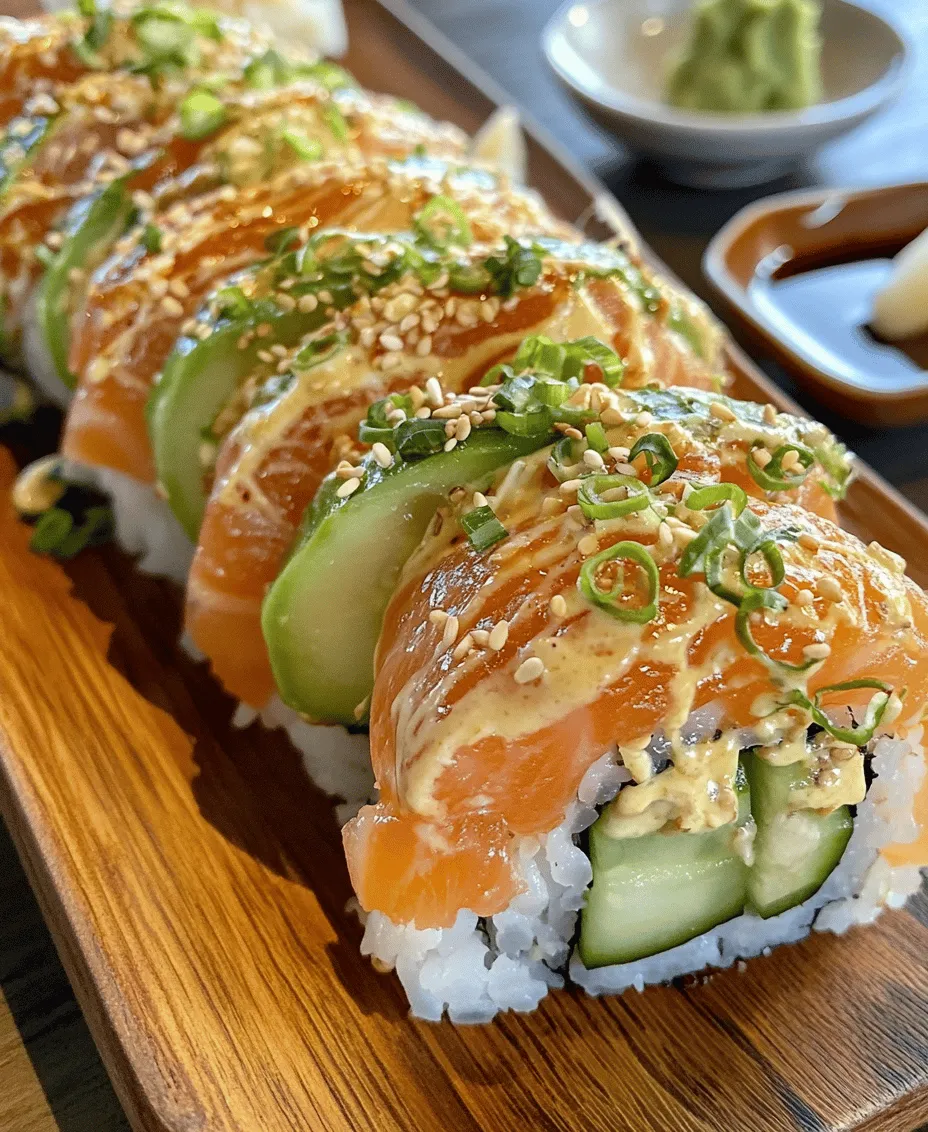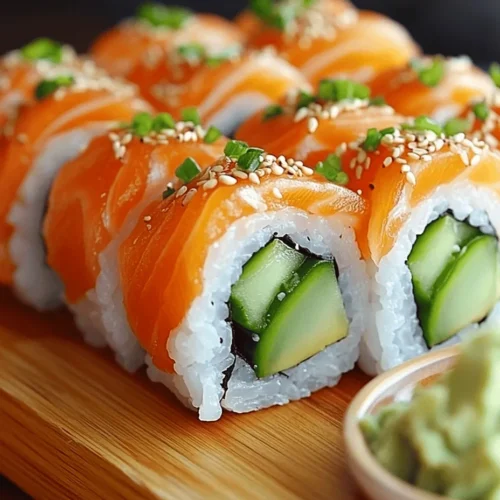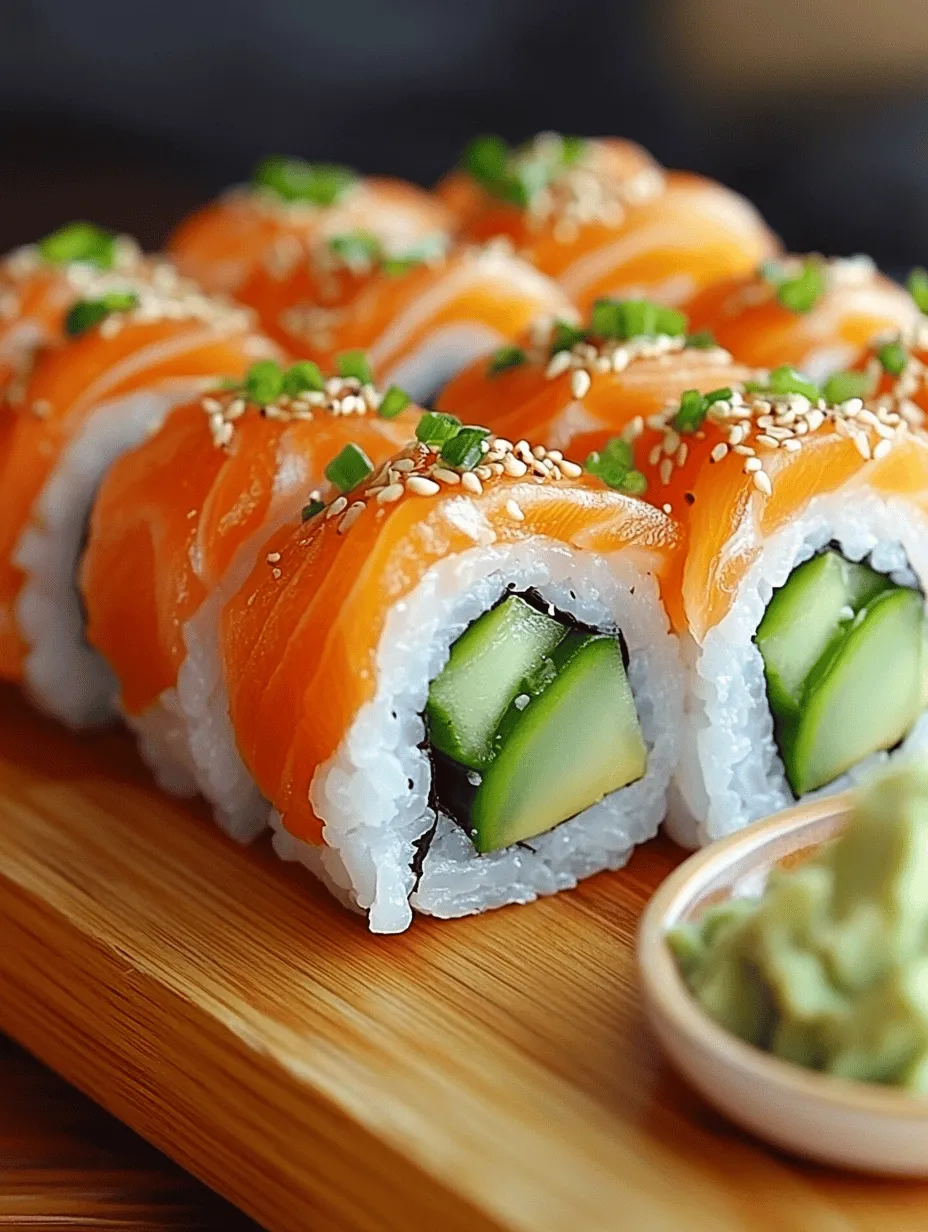Introduction
Sushi is not just a meal; it’s an experience that has captivated taste buds around the world. The combination of fresh seafood, seasoned rice, and vibrant vegetables creates a dish that is as beautiful as it is delicious. However, the traditional sushi-making process can often be intimidating, especially for those who are new to cooking or unfamiliar with the intricate techniques involved in rolling sushi. This is where the Baked Salmon Sushi Delight comes in—a delightful and approachable twist on a classic favorite.
Imagine savoring the rich, buttery flavor of baked salmon nestled atop perfectly seasoned sushi rice, all combined with fresh vegetables for an explosion of taste and texture. This dish not only simplifies the sushi-making process but also allows you to enjoy the flavors of sushi without the need for raw fish. Whether you’re a seasoned sushi enthusiast or a beginner looking to expand your culinary repertoire, this recipe is designed to be easy to follow and immensely satisfying.
In this article, we will delve into the history and cultural significance of sushi, explore the essential ingredients that make this dish shine, and guide you through the step-by-step preparation of Baked Salmon Sushi Delight. Get ready to embark on a culinary adventure that brings the joy of sushi-making right into your kitchen!
Understanding Sushi and Its Variations
Defining Sushi: A Brief Overview
At its core, sushi is a Japanese dish that primarily consists of vinegared rice accompanied by a variety of ingredients, which may include seafood, vegetables, and sometimes tropical fruits. The term “sushi” actually refers to the rice itself, which is seasoned with a mixture of vinegar, sugar, and salt. While many people associate sushi with raw fish, the truth is that sushi encompasses a wide variety of preparations and flavors, making it accessible to a diverse audience.
Exploring the Different Types of Sushi
Sushi comes in several forms, each showcasing unique flavors and presentation styles. Here are some popular types of sushi:
– Nigiri: Hand-formed rice topped with a slice of fish or seafood.
– Sashimi: Thinly sliced raw fish, often served with soy sauce and wasabi, but without rice.
– Maki: Rolled sushi, where rice and fillings are wrapped in a sheet of nori (seaweed).
– Temaki: Hand-rolled sushi cones filled with rice and various ingredients.
– Uramaki: Inside-out rolls with rice on the outside and nori on the inside, often filled with a mix of ingredients.
With the Baked Salmon Sushi Delight, we are introducing a new category of sushi that marries the traditional elements with a modern, cooked twist. This dish is perfect for those who prefer cooked seafood or are seeking a fun and interactive cooking experience.
The Cultural Significance of Sushi in Japanese Cuisine
Sushi has deep cultural roots in Japan, dating back to the 8th century when it was originally a method of preserving fish in fermented rice. Over the centuries, sushi evolved into the forms we recognize today, becoming a staple of Japanese cuisine. It is often enjoyed during special occasions and celebrations, symbolizing good fortune and prosperity.
In modern society, sushi has transcended its geographical boundaries and has become a global phenomenon. Sushi bars and restaurants can be found in cities worldwide, each offering their own unique takes on this traditional dish. However, the essence of sushi remains the same: a celebration of fresh ingredients and the art of presentation.
The Rise of Cooked Sushi: Embracing Inclusivity in Sushi Preparation
As sushi gained popularity outside of Japan, a new trend emerged—the rise of cooked sushi. This evolution has opened the door for many who may have been hesitant to try sushi due to the raw fish component. Cooked sushi options, such as tempura rolls and baked varieties, have made this beloved dish more inclusive and approachable for everyone.
Baked Salmon Sushi Delight is a perfect example of this trend. It allows home cooks to enjoy the flavors of sushi while eliminating the need for raw ingredients. By baking the salmon, we not only enhance its flavor but also ensure that it is safe and satisfying for all palates.
Ingredients for Baked Salmon Sushi Delight
Essential Ingredients Breakdown
To create a delicious Baked Salmon Sushi Delight, you’ll need a selection of fresh and high-quality ingredients. Here’s a breakdown of what you’ll need:
1. Sushi Rice: This short-grain rice is essential for sushi, as it becomes sticky when cooked, allowing it to hold together.
2. Fresh Salmon: Opt for high-quality salmon, whether fresh or frozen, to ensure flavor and safety in your dish.
3. Nori (Seaweed): Used for wrapping the sushi, nori adds a unique flavor and texture.
4. Avocado: Creamy and rich, avocado complements the salmon beautifully.
5. Cucumber: Adds a refreshing crunch and balances the richness of the salmon and avocado.
6. Soy Sauce: A classic accompaniment for sushi, soy sauce enhances the flavors of your dish.
7. Sushi Vinegar: A mixture of rice vinegar, sugar, and salt to season the rice.
Highlighting the Role of Each Ingredient
Each ingredient plays a crucial role in achieving the perfect flavor and texture in your Baked Salmon Sushi Delight. The sushi rice serves as the foundation, providing a sticky and flavorful base. The salmon, being the star of the dish, contributes a rich taste and a buttery texture when baked. Avocado adds creaminess, while cucumber brings a refreshing crunch, creating a delightful contrast in textures. Finally, the soy sauce ties everything together, adding a savory umami flavor.
Choosing the Right Salmon: Fresh vs. Frozen
When it comes to selecting salmon for your sushi, quality is paramount. Fresh salmon is ideal for its flavor and texture, but if it’s not readily available, frozen salmon is a great alternative. When choosing frozen salmon, opt for sushi-grade fish that has been flash-frozen to maintain its freshness. Always check the packaging for quality assurance and ensure the fish is stored at the correct temperature to avoid spoilage.
The Importance of Quality Sushi Rice
Sushi rice is another critical component that can make or break your dish. Look for short-grain sushi rice, as it has the right amount of starch to create the sticky texture needed for sushi. It’s also essential to rinse the rice before cooking to remove excess starch, which can lead to overly gummy rice. The seasoning of the rice with sushi vinegar is equally important, as it provides the characteristic tangy flavor that complements the other ingredients.
Selecting Fresh Vegetables: Avocado and Cucumber
Choosing fresh vegetables is vital for the overall taste of your Baked Salmon Sushi Delight. When selecting avocado, look for ones that are ripe but not overly soft. A perfectly ripe avocado will be creamy and easy to slice. For cucumbers, opt for firm, fresh specimens that will add a satisfying crunch to your sushi. Both ingredients not only enhance the flavor but also contribute to the visual appeal of your dish.
Step-by-Step Preparation of Baked Salmon Sushi Delight
Preparing the Sushi Rice
The first step in making your Baked Salmon Sushi Delight is preparing the sushi rice. Follow these detailed steps to ensure perfect rice every time.
Rinsing and Cooking Sushi Rice
Start by measuring out the desired amount of sushi rice, typically about 2 cups for a family-sized batch. Rinse the rice under cold water in a fine-mesh sieve until the water runs clear. This process removes excess starch, preventing the rice from becoming too sticky. After rinsing, let the rice drain for about 30 minutes to an hour.
Next, transfer the rinsed rice to a rice cooker or a medium saucepan. Add the appropriate amount of water—generally, the ratio is 1:1.2 rice to water for sushi rice. Cook the rice according to your cooker’s instructions, or bring it to a boil on the stovetop, reduce the heat to low, cover, and simmer for about 18-20 minutes, until the water is absorbed.
Seasoning the Rice: Creating the Perfect Flavor Profile
While the rice cooks, prepare the sushi vinegar. In a small bowl, combine ¼ cup rice vinegar, 2 tablespoons sugar, and 1 teaspoon salt. Microwave or heat gently on the stovetop until the sugar and salt dissolve completely. This mixture will enhance the flavor of your rice, giving it that authentic sushi taste.
Once the rice is done cooking, transfer it to a large wooden or plastic bowl. Gradually drizzle the sushi vinegar mixture over the warm rice, gently folding it in with a wooden paddle or spatula. Be careful not to mash the rice—your goal is to incorporate the seasoning while maintaining the grains’ integrity.
Cooling the Rice: Why It Matters
After seasoning the rice, it’s essential to cool it down to room temperature. This step is crucial for achieving the right texture for sushi. You can spread the rice out in a thin layer on a baking sheet or let it sit in the bowl while fanning it gently. Cooling the rice also allows it to become slightly sticky, making it easier to work with when assembling your sushi.
Baking the Salmon
With the sushi rice prepared, it’s time to focus on the salmon, the star of our Baked Salmon Sushi Delight.
Prepping the Oven: Ideal Temperature and Timing
Preheat your oven to 375°F (190°C). While the oven heats, prepare the salmon fillet by patting it dry with paper towels. This will help the salmon cook evenly and develop a nice crust. Season the salmon with salt and pepper, and if desired, brush a light layer of soy sauce or teriyaki sauce on top for added flavor.
Place the salmon on a lined baking sheet, skin-side down, and bake for about 15-20 minutes or until it is cooked through and flakes easily with a fork. The cooking time may vary depending on the thickness of your fillet, so keep an eye on it to avoid overcooking.
By following these steps, you are well on your way to creating a mouthwatering Baked Salmon Sushi Delight that is sure to impress your family and friends. In the next section, we will explore the fun of assembling your sushi and the finishing touches that will elevate this dish to new heights. Stay tuned for more delicious details!

Seasoning Techniques: Enhancing Flavor with Soy Sauce and Sesame Oil
The secret to elevating your Baked Salmon Sushi Delight lies in the seasoning. Soy sauce and sesame oil are essential for adding depth and richness to the dish. When preparing the salmon, consider marinating it in a mixture of soy sauce, sesame oil, and a hint of mirin or rice vinegar for about 30 minutes before baking. This not only infuses the fish with flavor but also enhances its natural umami taste.
For an added layer of flavor, you can sprinkle some toasted sesame seeds over the salmon before baking. The nutty aroma of toasted sesame seeds complements the fish beautifully and provides a delightful crunch. This method transforms the salmon into a flavor powerhouse, making every bite a delicious experience.
Knowing When the Salmon is Perfectly Cooked
Cooking salmon to perfection is crucial for your sushi rolls. The ideal doneness for salmon in sushi is a tender, moist texture that can be easily flaked. When you bake your salmon, aim for an internal temperature of 145°F (63°C). To check for doneness, insert a fork into the thickest part of the fish; it should flake easily and appear opaque with a slightly pink center.
If you prefer a slightly less cooked texture, you can remove the salmon from the oven when it reaches an internal temperature of 130°F (54°C). This will give you a more sushi-like, tender bite while still ensuring safety for consumption. Once cooked, allow the salmon to rest for a few minutes before assembling your sushi rolls.
Assembling the Sushi Rolls
Using Nori: Tips for Choosing and Handling Seaweed
Nori, the seaweed used for sushi, is a crucial component that adds flavor and texture to your rolls. When choosing nori, look for high-quality sheets that are dark green and shiny. Avoid sheets that are dull or brittle, as they may not hold up well during assembly.
To handle nori properly, cut the sheets in half if you prefer smaller rolls or leave them whole for larger sushi. Before using, you can lightly toast the nori over an open flame or in a dry skillet for a few seconds. This enhances its flavor and makes it easier to roll.
Layering Ingredients: The Art of Sushi Assembly
When assembling your sushi rolls, the key is to create a balanced layer of ingredients. Start with a sheet of nori placed on a bamboo sushi mat or a clean, flat surface. Spread a thin layer of sushi rice over the nori, leaving about an inch of space at the top edge to allow for sealing the roll later.
Next, layer your ingredients. Begin with a piece of the baked salmon, then add your favorite fillings—avocado slices, cucumber strips, or even cream cheese for a unique twist. Be careful not to overfill; a little goes a long way, and it will be easier to roll and slice your sushi.
Rolling Techniques: Achieving a Tight Roll
Rolling sushi can be a bit tricky, but with practice, you’ll master the technique. Begin at the bottom edge of the nori where the rice is spread. Using the bamboo mat, gently lift the edge of the mat and start rolling it towards the top. Keep the roll tight but not too tight—too much pressure can squeeze the ingredients out.
Once you reach the exposed edge of the nori, dampen it with a little water, which will help it stick and seal the roll. Continue rolling until you reach the end, ensuring that the roll is secure. Repeat the process with the remaining nori sheets and ingredients.
Slicing and Plating
Techniques for Slicing Sushi Rolls
To slice your sushi rolls, use a sharp knife that has been moistened with water. This prevents the rice from sticking to the blade and ensures clean cuts. Start by cutting the roll in half, then slice each half into smaller pieces, typically about 1 to 1.5 inches wide. For a professional look, aim for an even number of slices for each roll.
Remember to clean the knife with a damp cloth between cuts to maintain the integrity of each piece. This attention to detail will make your sushi rolls look as good as they taste.
Presentation Tips: Making Your Sushi Visually Appealing
The presentation of your Baked Salmon Sushi Delight is as important as its taste. Arrange the sushi pieces artfully on a platter, alternating the direction of the slices for visual interest. You can also garnish the plate with pickled ginger, wasabi, and a sprinkle of sesame seeds for an added touch.
Using decorative dishes or serving boards can enhance the presentation further. Consider adding a few flower petals or fresh herbs like cilantro for a pop of color. The appeal of your dish will entice your guests even before they take their first bite.
Garnishing Ideas: Elevating the Dish with Sesame Seeds and Green Onions
To elevate the flavor and visual allure of your sushi rolls, consider garnishing with toasted sesame seeds and finely chopped green onions. These additions provide a lovely crunch and a burst of fresh flavor that complements the richness of the salmon.
You can sprinkle sesame seeds over the top of the sushi rolls or serve them on the side for dipping. Finely sliced green onions can be scattered across the platter, giving your dish a fresh, vibrant look.
Serving Suggestions for Baked Salmon Sushi Delight
Pairing Sushi with Traditional Condiments
No sushi experience is complete without traditional Japanese condiments. Serve your Baked Salmon Sushi Delight with small bowls of soy sauce for dipping, and consider offering a side of pickled ginger and wasabi.
Wasabi: Understanding Its Use and Flavor
Wasabi adds a spicy kick that can enhance the flavors of your sushi. Its sharpness can be overwhelming, so use it sparingly. A small dab placed on top of a sushi piece or mixed into soy sauce can provide just the right amount of heat without overpowering the delicate flavors of the salmon.
Pickled Ginger: A Palate Cleanser
Pickled ginger, or gari, is traditionally served with sushi as a palate cleanser. Its sweetness and acidity help to refresh the taste buds between different sushi varieties. Place a small mound of pickled ginger on the side of your serving platter for guests to enjoy alongside their sushi rolls.
Beverage Pairings: What to Drink with Sushi
Pairing drinks with sushi can enhance the overall dining experience. Sake, a traditional Japanese rice wine, complements the flavors of sushi beautifully. If you prefer something non-alcoholic, green tea is an excellent choice, offering a subtle flavor that doesn’t compete with the sushi. Light beers, like lagers or pilsners, can also work well, cutting through the richness of salmon.
Nutritional Benefits of Baked Salmon Sushi Delight
Health Benefits of Salmon: Omega-3 Fatty Acids and More
Salmon is renowned for its health benefits, primarily due to its high concentration of omega-3 fatty acids. These essential fats are known to support cardiovascular health, reduce inflammation, and promote brain function. Incorporating salmon into your diet can be a delicious way to boost your intake of these beneficial nutrients.
The Nutritional Value of Sushi Rice and Vegetables
Sushi rice, while often seen as a simple carbohydrate, provides a source of energy and can be part of a balanced meal. When combined with fresh vegetables like cucumber, avocado, and carrots, your Baked Salmon Sushi Delight becomes a nutrient-rich dish packed with vitamins, minerals, and fiber.
Balancing Flavor and Nutrition: A Healthier Sushi Option
By preparing sushi at home, you control the ingredients, allowing you to create a healthier version that suits your dietary preferences. Baked salmon, combined with wholesome vegetables and the right seasonings, delivers a meal that is both satisfying and nutritious. This dish offers a great way to enjoy the flavors of traditional sushi while keeping health in mind.
Conclusion
Baked Salmon Sushi Delight is not only a delicious meal but also a fun and engaging culinary experience. This recipe brings the art of sushi-making into your kitchen, allowing you to enjoy fresh flavors without the need for raw fish. By following the steps outlined above, you can create a dish that is sure to impress and satisfy. Embrace your creativity and enjoy the process of making sushi at home, celebrating the rich traditions of this iconic cuisine while adding your personal touch. Whether you’re serving it for a special occasion or simply treating yourself to a delightful meal, this sushi recipe is bound to become a favorite in your culinary repertoire.



